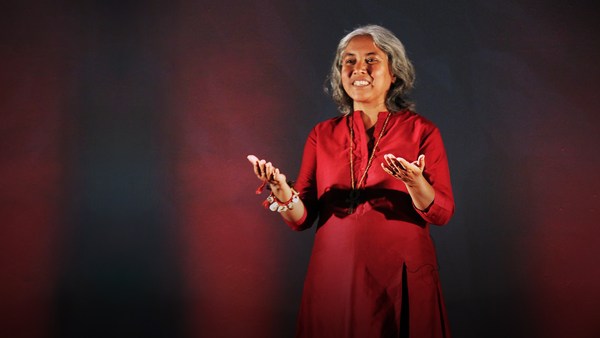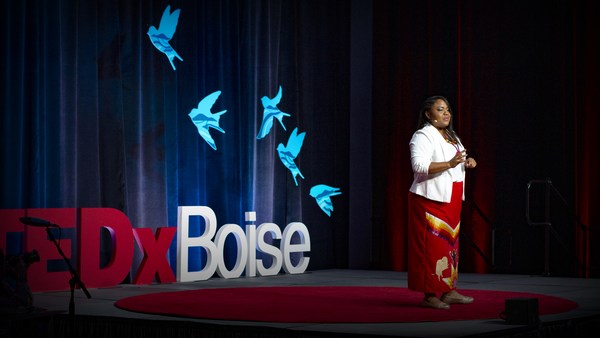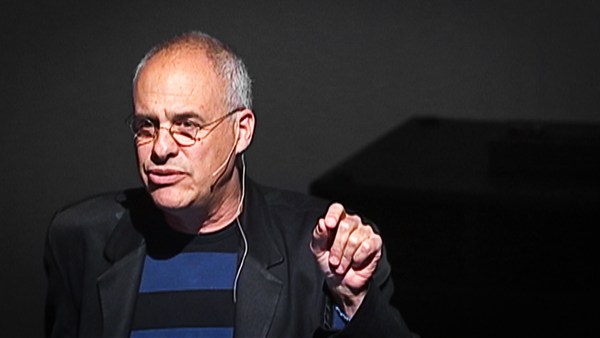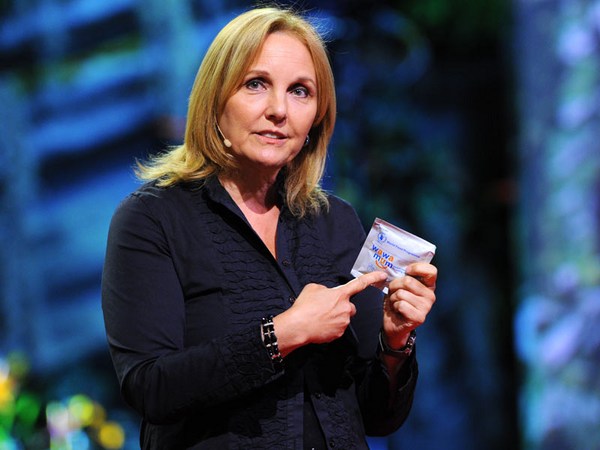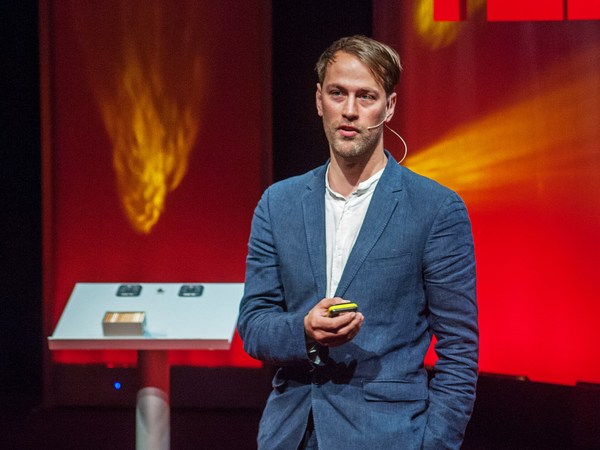Hi there, my name is Sean Sherman, I am a chef. Unfortunately, I don't have food for you guys tonight. Food for thought, I guess, maybe. I'm here to talk about Native American food.
I was born and raised in Pine Ridge in South Dakota, and our focus are on Indigenous foods. And, you know, it's been a really interesting journey so far. I started my company called The Sioux Chef -- S-I-O-U-X, a little play on words -- back in 2014. But it had come from quite a few years of trying to research and understand because I kind of grew up in restaurants. I grew up in Pine Ridge. I grew up in Spearfish and in South Dakota in the Black Hills. And I started working a lot of touristy restaurants. And, you know, I had just a long career. All through high school and college, I worked restaurants. After college, I moved to Minneapolis. I became a chef at a young age in the city. And I'd just been cheffing for a long time. And a few years into my chef career, I realized the complete absence of Indigenous foods. And even for myself, I realized that I couldn't even name -- I could name less than a handful of Lakota recipes that were truly Lakota, things without cream of mushroom soup in it, right?
(Laughter)
So I was really trying -- It, you know, put me on a path to try and understand what happened, like where are all the Native American foods at, you know? And so it's been really interesting. So Indigenous foods, that shouldn't be -- there shouldn't be a big question mark, you know, we should know about it, because no matter where we are in North America, we're -- you know, North America obviously begins, all of its history begins with Indigenous history, right? And no matter where we are, we're standing on indigenous land. And so we should have a really good, strong sense of Native American food because it's just the land that we're on. It's just the history of the land that we're on. So for us, it became more than just serving foods. It really became talking about it and talking about why it isn't here. And I think it's a really important story for us to know. And it's also really important to see the benefit of why understanding Indigenous foods could really help all of us in the future.
So, you know, but where are all the Native American restaurants? We live in a world today, you know, where we have -- as the US, we’re like food capitals of the world, right? We have some of the best restaurants in New York City, in Chicago and LA, and zero Indigenous restaurants that are focused on the land that they're sitting on, which is kind of insane. You can have every other restaurants -- and Indian restaurants don't count, because that was my only choice on Facebook, because when I was trying to decide how to describe our restaurant -- is it Indian or is it new American or old American?
But anyways, so what we've done is like we tried to focus on, first off, just understanding what were precontact foods, precolonial foods. And I realized that that term didn't even really make a lot of sense to people. So I think it's really important to go through the storyline because to understand colonial or what is a precolonial food, you have to understand colonialism itself. And to understand colonialism, the easiest way is just to Google it. So if you Google the word "colonialism," you'll get a definition, "it's a policy or practice of acquiring full or partial political control over another country, occupying it with settlers and exploiting it economically." And this is something that's happened not uniquely here. It's happened all across the globe. So all over the Americas, North and South, all over Africa, all over India, all over Southeast Asia, Australia, New Zealand, Hawaii, you name it, like this has been a very common history for a lot of areas around the globe. For the US, which is our focus, because we're right here smack dab in the middle of the United States, it's really important to understand the history because the US did a really good job of smudging its history a little bit. So if you're going through high school, the history you get on Indigenous peoples probably isn't the best history. So you really should read a little bit more about what really happened.
So let's start with Manifest Destiny, which is really kind of something that was born from the idea of what was originally doctrine of discovery, which basically gave European powers their own rights to say, if we discover it, then we own it. Right? But that policy doesn't really work that well, because if you go into an Apple Store and you discover a brand new MacBook, most likely you're not going to have the rights to walk out the door with it. But a lot of our policies and a lot of -- like, our country was built on this notion that we just have this right to everything, right?
And people have to remember how young our history is. We're such a young country, you know? There's like, barely any time has passed. So just go back a couple hundred years and, like, start with 1800s. So in 1800, the United States is still not much more than just the 13 colonies at that point in history. And it’s the 1800s that are the most deadly century for Indigenous peoples. So a lot of really bad things happened during this time period, because in 1800, in reality, almost all of what is the US is still completely occupied by Indigenous peoples and communities and a huge diversity of them across the board. Even despite European powers having big land claims, you know, France has a big section and Spain's got big chunks and England is holding on to chunks and Russia is coming in and there's all sorts of just big land grabs happening. But in reality, it's the Indigenous communities that have always been there. But this century is a mass century of change, you know. So during this time period, things move really fast. So this is just a really tough time.
And for me, this is like my great-grandfather's era because my great-grandfather was born in the late 1850s and during his lifetime, he sees so much change so quickly, he sees so many battles between the Lakota and the US government. He sees the Battle of Little Bighorn when he's 18 years old, during the battle on the Lakota side. He sees his kids having to go to boarding school, cut their hair, learn to speak English, learn Christianity. He sees his children -- some of his children even grow up to fight for the US government. So it's such a crazy amount of change to see in one single lifetime, right? And during this time period, people are getting pushed around. At the beginning of that century, over 80 percent of that landmass was under Indigenous control. And by the end of the century less than two percent, only because of the reservation systems. And this is all just part of the story of why there aren't Native American restaurants, because we just went through a really traumatic time in history where we're still -- we haven't even had the time to heal yet, let alone evolve, right, when it comes down to all this.
So the US history, you know, there's a lot of these big movements like the Indian Removal Act of 1830, the Homestead Act of 1862, the Indian Appropriation Act that basically said we're wards the states, that we're not our own entities anymore, the Dawes Act of 1887. And all these pieces were very focused and the government was really, really good at what they did, you know. And it all starts with taking our food away from us. So the loss of Indigenous food is something that starts from the very beginning. George Washington, one of his very first things that he does is send General Sullivan out to push all the native people outside of the US. He wanted them captured. He wanted them brought back. And they went on this march that lasts a single summer and does just that. So after a single summer, there's no more native people in all of that New York area, from D.C. all the way up, basically. And they named George Washington the president. They gave the name for a US president: Town Destroyer, which is still the name that they use today because he just devastated a whole area. And this is the precedent that gets set for how the US government treats the Indigenous peoples throughout the next century, basically.
So here, in our area, the very systematic destruction of bison, which they knew would hurt a lot of people, and it did. And by the end of the century, there was less than 500 on the planet. And it was very purposeful. So ... But I think what's most damaging for us and why we don't have a lot of Indigenous restaurants out there was the loss of our education, because this whole generation, like my great-grandfather's generation and my grandfather's generation especially, like, those generations should have been getting the full extent of Indigenous education. They should have been learning everything their ancestors intended them to learn. How to fish, how to hunt, how to gather, how to identify plants, how to live sustainably, utilising plants and animals around us. But instead, we went through a really intense assimilation period where we basically, you know, the boarding school systems stripped this whole generation of all that knowledge and education. And it became very traumatic because this was not a fun situation for these kids to go through. This was a military-style school and they popped up all over the US, all over Canada. These kids being again forced to speak different languages, forced to learn new religions, forced to learn skills that had nothing to do with them. And being forced to is the situation. You know, a lot of these kids perished. We shouldn't have to worry about sending kids to school to see if they'll survive or not. But this was a very harsh situation for kids to go through. And they went through physical abuse, sexual abuse. They went through mental abuse. And we're still reeling from that in our communities today because of this direct link to the trauma that happened there.
And being Indigenous in the 1900s wasn't much better. My grandparents were born before they were even citizens, which doesn't happen until 1924. And then in the 40s and 60s, the US government started dismantling a lot of tribes. So over 100 tribes got dismantled so they could continue to take over more land spaces. We couldn't vote until 1965. We couldn't celebrate religions until '78, you know. So what does it look like for me growing up in this? I was born in the mid-70s and growing up in postcolonial America. Like, what kind of foods was I eating? And I get asked that a lot because people in the media are always like, "You're native, like what kind of foods did you grow up with?" Because they want to hear a cool story like, "I'd get up in the morning, take down an elk with a slingshot, we'd have a big family feast." But that wasn't the reality, because like I grew up with the Commodity Food Program because we were poor, like a lot of people on the reservation. And we didn't even have the pretty cans when I was growing up. We just had, you know, these black and white cans, beef with juices. And that's dinner, you know, and that sucks. So ... And Indian tacos, you know, even when I was a kid, I was like, why does our Lakota food taste like Mexican food? It didn't even make sense to me at the time. Because we could do better than this. There's so much more to learn and more to offer with indigenous foods.
So it’s really important to understand what Indigenous foods are. But first, you have to understand just like how diverse our nation is. We're so diverse, there's all sorts of plants and animals out there. And when you layer Indigenous peoples on it, you can see so much amazing diversity, you know? This is a language map. So just look at all those huge color blocks and within those color blocks there's all sorts of diversity within those two, right? Still today, we have 634 tribes in Canada, 573 in the US and 20 percent of Mexico identifies as Indigenous. So there's an immense amount of indigeneity out there today and we should be celebrating that diversity because it's awesome. You know, just compare colonial settler states to Indigenous territories and you can see that diversity. It should change everywhere we go. You know, the US, the food system shouldn't just be hamburgers across the board, or in Canada shouldn't just be poutine. We could do so much better describing our foods, right? And so we have to really focus on Indigenous education because it's important for us to learn.
So when we're looking at Indigenous education, it's a study of all these pieces, wild food, permaculture, native agriculture, seed saving, seasonal lifestyles, ethno-oceanography, hunting, fishing, whole animal butchery, mycology, salt, sugar and fat productions, crafting, land stewardship, cooking, metallurgy, Indigenous history, traditional medicines, food preservation, fermentation, nutrition, health, spirituality, gender roles, sustainability -- all of that stuff is this really important education that we need to learn, you know.
So let's just break down some foods real quick. Proteins are easy. We learn about how natives were able to use every single part of a bison. But that's just because we didn't have the privilege to be wasteful. We figured out how to be resourceful with everything that we had and we treated everything like that. But basically, anything moving around is literally game. And we cut out beef, pork and chicken because those animals didn't exist here. And there are other animals to eat out there that aren't those three. So there's just a ton of stuff out there. And you shouldn't be afraid of something if it's not a cow, a pig or a chicken because there's a lot of cool foods out there, and even insects, it's so normal in so many parts of the world and it was normal here, too. But for us, our biggest love is plant knowledge because you start to learn the plants around us, you just see food and medicine everywhere. The Western diet has never really taken the time to learn this amazing biology that surround us and all these plants all around us. Because there's so much to learn. There's all sorts of staples out there, like the timpsula, which is the prairie turnip which grows around these plains. Camas root from the Pacific Northwest, wild rice from the Great Lakes, even just seaweed out there in the oceans, which a lot of families were utilizing, or in the deserts where all the plants look like they want to hurt you or maim you. The Indigenous peoples knew how to live with them.
And another piece like the domesticated piece, with all the agriculture, it's really important, because we think of this as agriculture but we know how damaging this is. And it's scary when you see headlines like, "What should we do if glyphosate was found in our Cheerios?" You guys should be really scared about that. That stuff's really nasty, you know. But it's just amazing to learn about Indigenous agriculture because it goes back so far and people figured out all sorts of ways to farm and build sustained, huge civilisations, whether they're in the middle of the desert, whether they're on the coastal regions, or way up here in the Dakotas. People were able to farm amazing things that had an amazing amount of diversity that we need to protect. We are the stewards of what's left of this diversity. And a lot of it got wiped off the map in the 1800s with all that colonialism that was going on. So we have to be understanding so we can protect these for the next generation because these could disappear if we don't do anything about it. So it's really important to understand that.
So to use Indigenous knowledge in today's world, it's just important to open up your eyes, you know, stop calling everything a weed because that just means you don't know what it is. You know, our kids can name more K-Pop bands than they can trees and that's your fault, you know?
(Laughter)
We need to teach them things that are important. Because, like, just look around. There's food everywhere and we should be making pantries, like our grandparents did, and our great-grandparents. They just used the food that was around us. So we should just be making our own pantries that tastes like where we are, what makes us unique in our own region. And that's why we should have Native American food restaurants all over the nation, run by Indigenous peoples. There's so much to explore. There's so much flavor. There's so much health. And it's just super healthy, you know, and it's fun for chefs to create and play with all these flavors. Chefs should be really excited about getting to learn all of these plants that aren't in their diet because they're just going out of a French cookbook. And for us, we just want to get this food back into tribal communities especially, and make people healthy and happy and break a lot of the cycle of, you know, government reliance on food and huge rates of type 2 diabetes and obesity and heart disease because of this low nutritional food base that the government's been feeding us for too long. And we just need to think about how we can adjust and make a better lifestyle. We need to use our land spaces better. Lawns are fucking stupid.
(Laughter)
We need to really do something better. We could just be growing food out there, you know? We could just be putting food plants everywhere. We need more community gardens, more permacultural landscapes. It's that easy. If we can grow 30 golf courses in Palm Springs in the middle of the desert, just think what we could do if we just did that for good and just put food everywhere, you know? An organic food, food that wants to grow in that certain region. So, you know, Indigenous diet is really the most ideal diet. It's healthy fats. It's diverse proteins, it's low carbs, it's low salt. It's a ton of plant diversity. It's organic agriculture. It's celebrating cultural and regional diversity. And it's seasonal. It's just really good. It's like what the paleo diet wishes it was, when it comes down to it, because that just makes sense, you know, and we need to protect this. We need to get this out there. And again, it's not unique here. There's Indigenous peoples all around the world and there's an Indigenous knowledge base that's basically untapped because of the colonial structure that's been put everywhere. We need to be protecting people in Africa and India and Southeast Asia and Australia, New Zealand, Hawaii, South America, North America. We need to protect those. We need to be celebrating diversity instead of trying to build stupid walls to keep people out. We need to have, you know, healthy food access, cultural food producers, regional food systems, local control of food systems, not governmental control, access to Indigenous education and environmental protections to protect a lot of this natural food that surround us. We need to be better connected to our nature around us and really, truly understand how it's a symbiotic relationship. We're not above it, right?
If we can control our food, we can control our future. And for us, it's an exciting time to be Indigenous because we are taking all of these lessons from our ancestors that should have been passed down to us, relearning them and utilizing the world today with everything it has to offer and becoming something different. We're at the stage where we're ready to evolve. This is an Indigenous evolution and revolution at the same time. So I hope someday that you can drive across this nation, stop at Indigenous-run food businesses and see this amazing amount of diversity out there and just think about it, you know.
